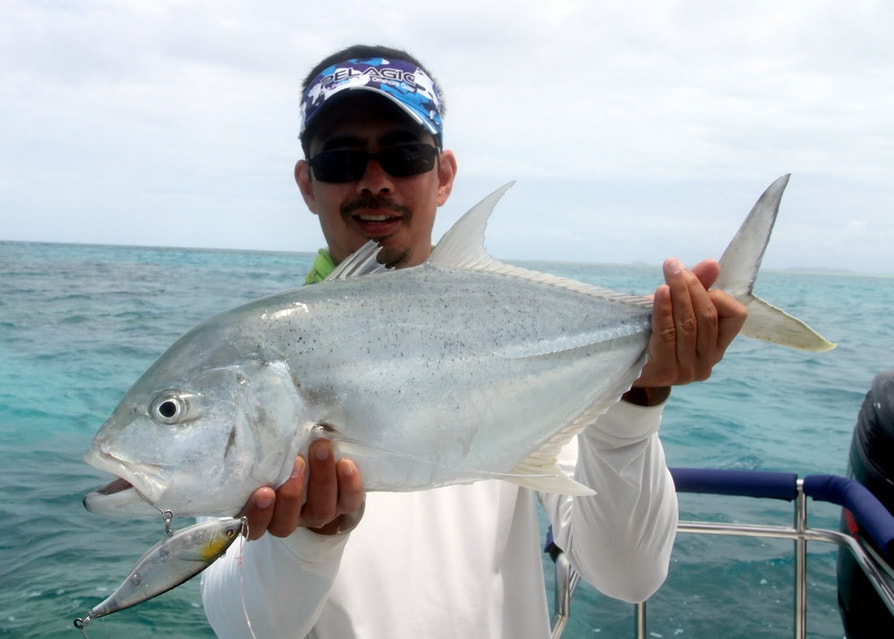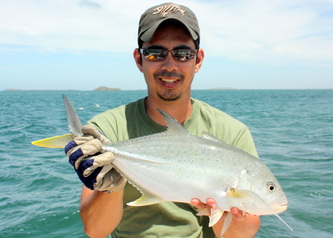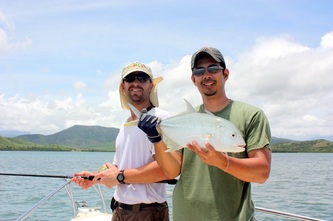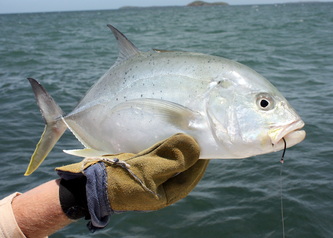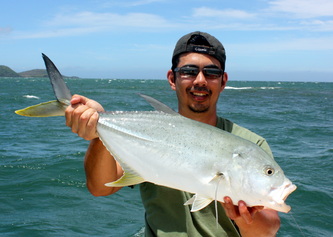Brassy Trevally
Caranx papuensis
Home
Other Species
Brassy Trevally Description
Brassy Trevally (also called tea leaf trevally and brassy kingfish) closely resemble the Giant Trevally but grow to a much smaller maximum size and have some yellow in their tails. They are a great light tackle fighter found in lagoons and reefs in the Indo Pacific. They are an aggressive fish that puts up quite a fight; when people first pull them up they are often surprised at how small they end up being compared to how hard the fight was. They are one of the strongest pound for pound fish in the world. Unfortunately they max out around 14 pounds.
Here is a video I made of my trip to the Great Barrier Reef which includes some Brassy Trevally: CLICK HERE
Brassy Trevally Pound for Pound Fight Rating - 8 out of 10 on the Saltwater Scale
Like all Trevally, Brassy Trevally are muscular and pull hard. They aren't experts at busting you off in the reef, but they will zip around rocks and cut your line if you let them.
Brassy Trevally Culinary Rating - Low
Brassy Trevally are certainly edible, but are not particularly sought after, especially compared to some of the other fish that live in the same areas.
Brassy Trevally Tackle
You should be able to land pretty much any Brassy Trevally on 30lb braid and a medium spinning outfit. Make sure you pull hard to get them away from the reefs where they live. I go armed with a Daiwa Certate spinning reel and a longish spinning rod in the 12lb class. Click here for tackle recommendations.
Brassy Trevally Techniques
Brassy Trevally readily eat both bait and lures, but I have caught most of mine on lures. This might be one of those fish for which lures consistently work better than bait because these fish are aggressive and like to chase things. Brassy Trevally can be caught using the same methods you would use to catch any other type of Trevally of the same size.
Brassy Trevally Lures
For smaller Brassy Trevally, I really like to use a clear plastic bobber, fill it with water, and then use a plastic strip about 30” past the bobber. You cast this as far as you can and immediately start reeling it in quickly while popping the rod tip every few seconds. This causes the plastic bobber to splash water and attracts the Brassy Trevally, which come to investigate the commotion and then inhale the plastic strip. This technique works on many types of Trevally as well as other reef fish. It is a surface technique so you can cast right over the top of a reef and start ripping it back. Of course, if something bites on the far side of the reef you can pretty much kiss your tackle goodbye and get ready to retie. Your leader must be as heavy as you can manage while still giving nice action to the plastic strip. I haven't been able to go heavier than 30lbs. A 5lb Brassy Trevally will give you a real run for your money on this rig.
Often you will find that fish attack the bobber, so you can attach a treble hook to it with a split ring and catch fish on the bobber as well as the plastic strip. If you want to get fancy you can also attach a red bead to the line ahead of the plastic strip. For the strips I like clear with various colors of glitter and aqua green. This technique is one of my favorites because a) it is not used in many places and b) you can see the fish come up to chase the lure. For aggressive fish this technique works wonders. It is very effective from shore if you don't have access to a boat.
The Sebile Stick Shad in the smaller sizes works very well on these fish. If they are near the surface, you can try small to medium size poppers or a Saltwater Heddon Zara Spook. Work them quickly with some pauses. Brassy Trevally are rarely interested in slow moving lures.
Brassy Trevally Baits
Brassy Trevally can be caught on a variety of live baits such as baitfish or dead baits such as octopus or shrimp. No fancy rigs are needed. I have not caught any on bait so I can’t comment too much on this though.
Where to get the big Brassy Trevally
New Caledonia and the Great Barrier Reef are good bets. There are supposed to be some big ones in Papua New Guinea as well.
Other Brassy Trevally Resources
The above barely scratches the surface on how to catch Brassy Trevally. The resources below will provide a wealth of information:
www.nomadsportfishing.com.au is an excellent source to catch these guys in Australia.
Caranx papuensis
Home
Other Species
Brassy Trevally Description
Brassy Trevally (also called tea leaf trevally and brassy kingfish) closely resemble the Giant Trevally but grow to a much smaller maximum size and have some yellow in their tails. They are a great light tackle fighter found in lagoons and reefs in the Indo Pacific. They are an aggressive fish that puts up quite a fight; when people first pull them up they are often surprised at how small they end up being compared to how hard the fight was. They are one of the strongest pound for pound fish in the world. Unfortunately they max out around 14 pounds.
Here is a video I made of my trip to the Great Barrier Reef which includes some Brassy Trevally: CLICK HERE
Brassy Trevally Pound for Pound Fight Rating - 8 out of 10 on the Saltwater Scale
Like all Trevally, Brassy Trevally are muscular and pull hard. They aren't experts at busting you off in the reef, but they will zip around rocks and cut your line if you let them.
Brassy Trevally Culinary Rating - Low
Brassy Trevally are certainly edible, but are not particularly sought after, especially compared to some of the other fish that live in the same areas.
Brassy Trevally Tackle
You should be able to land pretty much any Brassy Trevally on 30lb braid and a medium spinning outfit. Make sure you pull hard to get them away from the reefs where they live. I go armed with a Daiwa Certate spinning reel and a longish spinning rod in the 12lb class. Click here for tackle recommendations.
Brassy Trevally Techniques
Brassy Trevally readily eat both bait and lures, but I have caught most of mine on lures. This might be one of those fish for which lures consistently work better than bait because these fish are aggressive and like to chase things. Brassy Trevally can be caught using the same methods you would use to catch any other type of Trevally of the same size.
Brassy Trevally Lures
For smaller Brassy Trevally, I really like to use a clear plastic bobber, fill it with water, and then use a plastic strip about 30” past the bobber. You cast this as far as you can and immediately start reeling it in quickly while popping the rod tip every few seconds. This causes the plastic bobber to splash water and attracts the Brassy Trevally, which come to investigate the commotion and then inhale the plastic strip. This technique works on many types of Trevally as well as other reef fish. It is a surface technique so you can cast right over the top of a reef and start ripping it back. Of course, if something bites on the far side of the reef you can pretty much kiss your tackle goodbye and get ready to retie. Your leader must be as heavy as you can manage while still giving nice action to the plastic strip. I haven't been able to go heavier than 30lbs. A 5lb Brassy Trevally will give you a real run for your money on this rig.
Often you will find that fish attack the bobber, so you can attach a treble hook to it with a split ring and catch fish on the bobber as well as the plastic strip. If you want to get fancy you can also attach a red bead to the line ahead of the plastic strip. For the strips I like clear with various colors of glitter and aqua green. This technique is one of my favorites because a) it is not used in many places and b) you can see the fish come up to chase the lure. For aggressive fish this technique works wonders. It is very effective from shore if you don't have access to a boat.
The Sebile Stick Shad in the smaller sizes works very well on these fish. If they are near the surface, you can try small to medium size poppers or a Saltwater Heddon Zara Spook. Work them quickly with some pauses. Brassy Trevally are rarely interested in slow moving lures.
Brassy Trevally Baits
Brassy Trevally can be caught on a variety of live baits such as baitfish or dead baits such as octopus or shrimp. No fancy rigs are needed. I have not caught any on bait so I can’t comment too much on this though.
Where to get the big Brassy Trevally
New Caledonia and the Great Barrier Reef are good bets. There are supposed to be some big ones in Papua New Guinea as well.
Other Brassy Trevally Resources
The above barely scratches the surface on how to catch Brassy Trevally. The resources below will provide a wealth of information:
www.nomadsportfishing.com.au is an excellent source to catch these guys in Australia.
